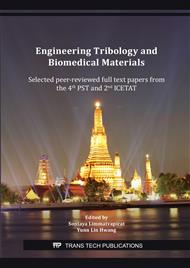[1]
N.A. Bushe, I.G. Goryacheva and Y.Y. Makhovskaya: Wear Vol. 254(12) (2003), p.1276.
Google Scholar
[2]
M. Górny and G. Sikora: Journal of Materials Engineering and Performance Vol. 24(3) (2015), p.1150.
Google Scholar
[3]
Z.C. Lu, Y. Gao, M.Q. Zeng and M. Zhu: Wear, Vol. 309(1-2) (2014), pp.216-225.
Google Scholar
[4]
P. Podrabinnik, I. Gershman, A. Mironov, E. Kuznetsova and P. Peretyagin: Lubricants, Vol. 6(4) (2018), p.104.
Google Scholar
[5]
M. Anil, V.C, Srivastava, M.K. Ghosh, and S.N. Ojha: Wear, Vol. 268(11-12) (2010), p.1250.
Google Scholar
[6]
B.Y. Sachek, A.M. Mezrin, T.I. Muravyeva, and O.O. Stolyarova: Journal of Friction and Wear, Vol. 37(5) (2016), p.469.
Google Scholar
[7]
A.M. Mezrin, O.O. Shcherbakova, T.I. Muravyeva, D.L. Zagorskiy and I.V. Shkalei: Frontiers in Mechanical Engineering, 5 (2019), p.14.
Google Scholar
[8]
A.M. Mezrin, O.O. Shcherbakova, T.I. Muravyeva, I.V. Shkalei and D.L. Zagorskiy: Journal of Friction and Wear, Vol. 40(5) (2019), p.369.
Google Scholar
[9]
A.O. Yakovleva, N.A. Belov, T.A. Bazlova, and I.V. Shkalei: Physics of Metals and Metallography, Vol. 119(1) (2018), p.35.
Google Scholar
[10]
O.O. Stolyarova, T.I. Muravyeva, D.L. Zagorskiy and N.A. Belov:. Microscopic analysis of the surface of multicomponent antifriction aluminum alloys, Physical Mesomekhanics, Vol. 19(5) (2016), p.105.
Google Scholar
[11]
O.O. Shcherbakova, T.I. Muravyeva, D.L. Zagorskiy and I.V. Shkalei: Russian Journal of Non-Ferrous Metals, Vol. 61 (2020), p.99.
DOI: 10.3103/s1067821220010149
Google Scholar
[12]
Y.Y. Makhovskaya, and I.G. Goryacheva: Physical Mesomechanics, Vol. 19(3) (2016), p.239.
Google Scholar
[13]
W.C. Oliver and G.M. Pharr: J. Mater. Res. Vol. 7 (1992), p.1564.
Google Scholar
[14]
E. Torskaya: Proceedings of the Institution of Mechanical Engineers, Part C: Journal of Mechanical Engineering Science 230(9) (2016), p.1392.
Google Scholar
[15]
E.V. Torskaya, T.I. Muravyeva and J.C. Sánchez-López: Lecture Notes in Mechanical Engineering, No 9783319956299 (2019), p.1011.
Google Scholar
[16]
ASTM, G77-05, Standard Test Method for Ranking Resistance of Materials to Sliding Wear Using Block-on-Ring Wear Test, (2008).
DOI: 10.1520/g0077
Google Scholar


